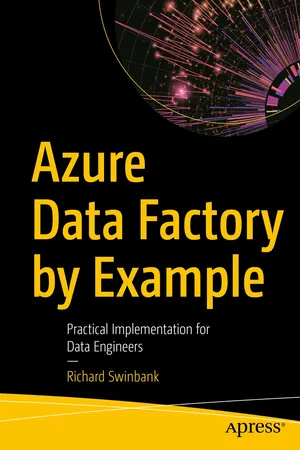
Azure Data Factory by Example
Practical Implementation for Data Engineers
- English
- ePUB (mobile friendly)
- Only available on web
About This Book
Data engineers who need to hit the ground running will use this book to build skills in Azure Data Factory v2 (ADF). The tutorial-first approach to ADF taken in this book gets you working from the first chapter, explaining key ideas naturally as you encounter them. From creating your first data factory to building complex, metadata-driven nested pipelines, the book guides you through essential concepts in Microsoft's cloud-based ETL/ELT platform. It introduces components indispensable for the movement and transformation of data in the cloud. Then it demonstrates the tools necessary to orchestrate, monitor, and manage those components.
The hands-on introduction to ADF found in this book is equally well-suited to data engineers embracing their first ETL/ELT toolset as it is to seasoned veterans of Microsoft's SQL Server Integration Services (SSIS). The example-driven approach leads you through ADF pipeline construction from the ground up, introducing important ideas and making learning natural and engaging. SSIS users will find concepts with familiar parallels, while ADF-first readers will quickly master those concepts through the book's steady building up of knowledge in successive chapters. Summaries of key concepts at the end of each chapter provide a ready reference that you can return to again and again. What You Will Learn
- Create pipelines, activities, datasets, and linked services
- Build reusable components using variables, parameters, and expressions
- Move data into and around Azure services automatically
- Transform data natively using ADF data flows and Power Query data wrangling
- Master flow-of-control and triggers for tightly orchestrated pipeline execution
- Publish and monitor pipelines easily and with confidence
Who This Book Is For
Data engineers and ETL developers taking their first steps in Azure Data Factory, SQL Server Integration Services users making the transition toward doing ETL in Microsoft's Azure cloud, and SQL Server database administrators involved in data warehousing and ETL operations
Frequently asked questions
Information
Table of contents
- Cover
- Front Matter
- 1. Creating an Azure Data Factory Instance
- 2. Your First Pipeline
- 3. The Copy Data Activity
- 4. Expressions
- 5. Parameters
- 6. Controlling Flow
- 7. Data Flows
- 8. Integration Runtimes
- 9. Power Query in ADF
- 10. Publishing to ADF
- 11. Triggers
- 12. Monitoring
- Back Matter